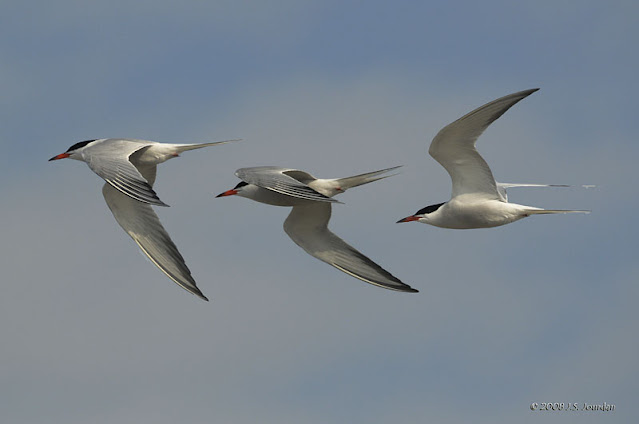Forster's & Common Terns - 21 Apr 2008
As we walked the North Causeway a group of Forster's Terns were chattering noisily their 'Kee-er' call on a log out in the middle of the Huron River. That got us talking about field marks for telling the birds apart. So after a successful day photographing both a Forster's and a Common Tern in flight, I've decided to review (hopefully correctly) some of the field marks to look for in both birds[1].
Before I do so, however, I will mention that we saw a flock of Dunlin in the Nelson Unit that also had (3) Lesser Yellowlegs and (2) Pectoral Sandpipers.
Before I do so, however, I will mention that we saw a flock of Dunlin in the Nelson Unit that also had (3) Lesser Yellowlegs and (2) Pectoral Sandpipers.
Out at Cell 3 a large flock of roosting Caspian Terns were making a ton of noise, and scattering smaller flocks of Bonaparte's Gulls, Forster's Terns and a couple dozen Dunlin.
At one point the flock dispersed and I managed several nice fly-by shots of a Forster's Tern. These composite shots show some of the field marks I look for: firstly the 'orange-red' bill and the silver-tipped primaries along the wingtips. At one point I managed to capture a series of photos of one bird dive-bombing the water in Cell 4 on just the other side of the dike.
In this composite you can see the 'darker-red' bill and wedge of dark gray-black feathers at the wingtips.
At one point the flock dispersed and I managed several nice fly-by shots of a Forster's Tern. These composite shots show some of the field marks I look for: firstly the 'orange-red' bill and the silver-tipped primaries along the wingtips. At one point I managed to capture a series of photos of one bird dive-bombing the water in Cell 4 on just the other side of the dike.
As I captured another fly-by of a couple of Forster's Terns a Common Tern passed by in the opposite direction calling it's 'Keeeeeeeeerrrr' call.
In this composite you can see the 'darker-red' bill and wedge of dark gray-black feathers at the wingtips.
When the birds are roosting look for the longer orange legs of the Forster's Tern while the Common Tern appears to have only exposed red feet. Wing projection in the Common Tern is also as long or longer than the tail, while the wings of a Forster's Tern is slightly shorter than the tail. Also note the ashy-gray belly of the Common Tern and compare that to the whiter belly of the Forster's Tern in the top image!
Just before leaving Cell 3 a fly-by Killdeer gave me a passing nod! As I returned to the car I found a 'small' Snapping Turtle in the middle of the dike, so I picked it up and released it back into the water out of harm's way.
[1] - Sibley, D.A., The Sibley Guide to Birds, 2000.
Pte. Mouillee SGA (permit required Sep 1-Dec 15), Monroe, Michigan, US
Apr 21, 2008 4:00 PM - 6:00 PM
Protocol: Traveling
5.0 mile(s)
6 species
Lesser Yellowlegs (Tringa flavipes) 3
Dunlin (Calidris alpina) 44
Pectoral Sandpiper (Calidris melanotos) 2
Bonaparte's Gull (Chroicocephalus philadelphia) 12
Caspian Tern (Hydroprogne caspia) 16
Forster's Tern (Sterna forsteri) 22
View this checklist online at https://ebird.org/checklist/S1
This report was generated automatically by eBird v3 (https://ebird.org/home)
Apr 21, 2008 4:00 PM - 6:00 PM
Protocol: Traveling
5.0 mile(s)
6 species
Lesser Yellowlegs (Tringa flavipes) 3
Dunlin (Calidris alpina) 44
Pectoral Sandpiper (Calidris melanotos) 2
Bonaparte's Gull (Chroicocephalus philadelphia) 12
Caspian Tern (Hydroprogne caspia) 16
Forster's Tern (Sterna forsteri) 22
View this checklist online at https://ebird.org/checklist/S1
This report was generated automatically by eBird v3 (https://ebird.org/home)










Comments
Post a Comment
Please leave a comment. I will try to respond ASAP.